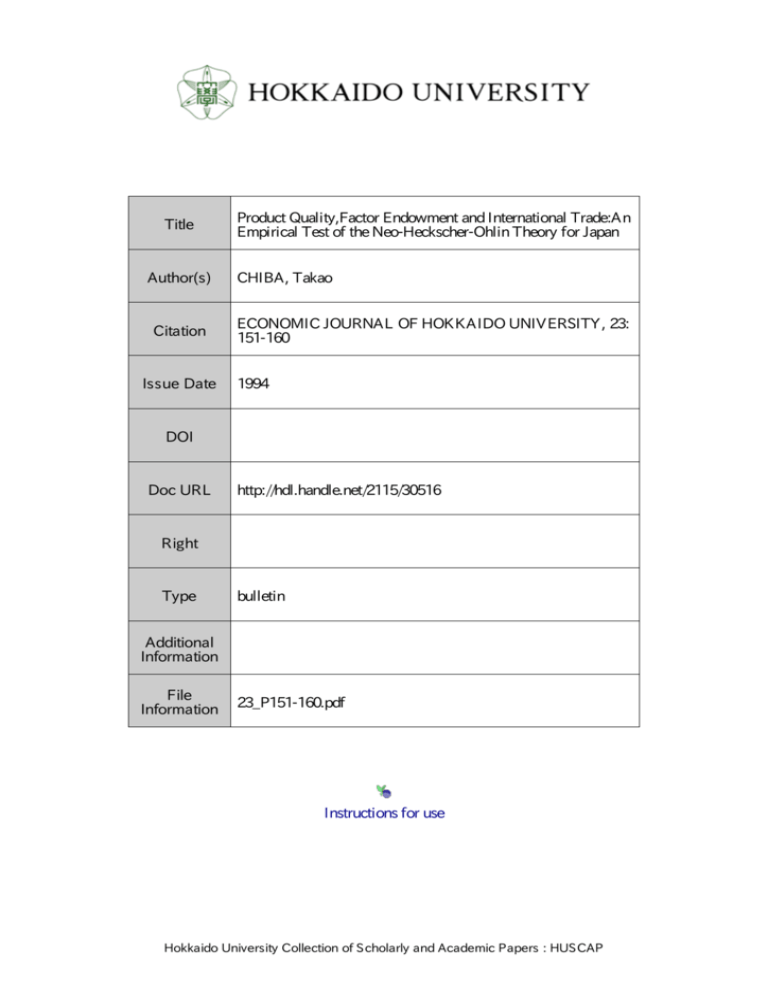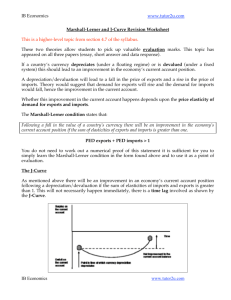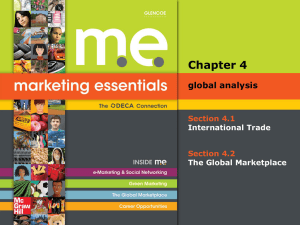Product Quality, Factor Endowment and International Trade: An
advertisement

Title
Author(s)
Citation
Issue Date
Product Quality,Factor Endowment and International Trade:An
Empirical Test of the Neo-Heckscher-Ohlin Theory for Japan
CHIBA, Takao
ECONOMIC JOURNAL OF HOKKAIDO UNIVERSITY, 23:
151-160
1994
DOI
Doc URL
http://hdl.handle.net/2115/30516
Right
Type
bulletin
Additional
Information
File
Information
23_P151-160.pdf
Instructions for use
Hokkaido University Collection of Scholarly and Academic Papers : HUSCAP
Econ. ]. of Hokkaido Univ.,
Vol. 23 (1994),
151
pp.139~150.
Product Quality, Factor Endowment and
International Trade: An Empirical Test of
the Neo-Heckscher-Ohlin Theory for Japan*
Takao
CHIBA
This paper presents a model of international trade that allows for
vertical differentiation and shows that Heckscher-Ohilin type trade should
occur. This model is then empirically tested for Japan, and finds that,
Japan exports high quality (capital intensive) products and imports low
quality (labor intensive) products as the theorem predicts.
1. Introduction
According to Reckscher-Ohlin trade theory, a country will export those
products that intensively use the factor of production, capital or labour, that the
country is abundant in; and import all other products. Accordingly, inter-industry type trade should predominantly occur. In reality, however, intraindustry
trade accounts for a significant proportion of trade in manufactured products,
i. e., countries both import and export the same and/or very similar products.
Krugman (1979) and Lancaster (1980) used models that incorporated imperfect competition with horizontal product differentiation, i. e., differentiation by
color and/or brand, and economies of scale to explain this phenomenon. These
models, however, fail to explain intra-industry trade that occurs between countries with different technology.
Flam and Relpman (1987) and Falvay and Kierzkowski (1987), however,
used vertical product differentiation, i. e., goods are differentiated by quality, to
explain intra-industry trade. Falvay and Kierzkowski argue that the quality of
a product is related to its production capital intensity, i. e., in order to produce
higher quality products, a larger amount of capital relative to labour is required.
Accordingly, when capital/labour ratios differ within product groups, countries
that are capital Clabour) abundant have a comparative advantage in producing
higher Clower) quality products. Thus capital Clabour) abundant countries will
produce and export high Clow) quality products, i. e., capital Clabour) intensive
products, and import all other products. This can be thought of as neo-Reckscher-Ohlin (neo-R -0) intra -industry trade.
Torstensson (1991) has tested the neo-R -0 trade theory empirically for
• I would like to thank Professor Hiroshi Ono and Wilson A. Alley for useful comments and
suggestions.
152
Takao
CHIBA
Sweden. He concluded that a positive relationship between the quality of a
country's exports and that country's capital/labour endowment ratio does exist.
He also found that products traded between Sweden and other capital abundant
countries were of almost identical quality, while products imported from labour
abundant countries were of lower quality than Sweden's exports. These results
empirically support the neo- H-O theory. The measure of product quality Torstensson used to test the theory, however, lacks a theoretical justification.
This paper empirically tests the neo-H-O theory for Japan. Japan's case is
interesting in that Japan's capital/labour ratio relative to other countries' capital/labour ratio has significantly increased. This paper tests to see if this
change in its capital/labour ratio is reflected in the change in quality, if any, of
its exports and imports. This paper is constructed as follows. In section 2 we
derive a utility consistent measure of quality of a country's exports relative to its
imports. Section 3 discusses the method used to test the neo- H -0 theory. Section 4 discusses the empirical results obtained, and these results are summarized
in section 5.
2. Model
Falvay and Kierzkowski assume there are two factors of production, capital and labour, and many products, where different products of different quality
make up a product group. We will also assume that the price of each product
reflects the quality of that product; i. e., the higher the price, the higher the
quality of the product. Furthermore, in order to produce higher quality products, a higher capital/labour ratio in production is necessary. Given product
quality is continuously differentiable, then each product group has a range of
poducticon capital/labour ratios. Lastly, the world consists of many countries.
Although all countries have access to the same technology, they have different
factor endowments and factor prices. We will also assume that no technological
progress occurs.
Under these assumptions, countries will specialize in producing a few products, which are also exported, while importing all other products, i. e., capital
(labour) abundant countries will export capital (labour) intensive products and
import all other products. When capital/labour ratios differ within product
groups, neo-H-O intra-industry trade will occur. That is, capital (labour) abundant countries will export the high (low) quality products and import all other
products of different quality.
In order to test the neo-Heckscher-Ohlin theory for Sweden, Torstensson
defined M (T), the measure of quality of Swedish exports relative to imports, as
n
M(T)=~{ln
i=l
P;(IMP)-ln P;(EXP)}/n
Product Quality, Factor Endowment and International Trade
153
where n is the number of product groups, P;CIMP) is the import price of product i and Pi(EXP) is the export price of product i. M(T), however, does not
reflect the quality of a country's exports relative to imports because it is the
simple geometrical average of all product groups. That is, the weight for all
product groups in M (T) is 1/ n, and this does not accurately take account of
consumer's preferences for different product groups.
We will argue that if the utility level is constant, then the measure of
quality should be unchanged, just like the price index. We will assume that consumers differ in income, that each consumer consumes only one product of a
given quality from each product group, and that consumers maximize their utility given their budget constraint. Suppose a utility function as follows:
n
(1)
*
U (21, 2';, ... , Zn) = i=l
~ Si In Z;
where Zi(>1) is the quality of product i, and Si(O<Si<l, ~Si=1) is a parameter.
We will assume the price of a product reflects its quality, i. e., price is an
increasing function of quality. For simplicity, we assume the price of product is
given by
where Ci is constant. Thus, the measure of quality, Q, is
Totally differentiating (1) and (2), it can be shown that the measure of quality
is constant as long as the level of utility remains constant.
The budget constraint of the consumer is
(3)
where I is the consumer's income and each consumer differs in income. Differentiating (1) subject to (3), we obtain,
n
(4)
Si=Pi(Z/)/{~Pi(Z/)}
i=l
where superscript e indicates the utility maximizing quality.
Consequentially, the utility consistent measure of quality of a country's
exports relative to imports is
n
(5)
M(T)'=~Si{ln Pi CIMP)-ln Pi(EXP)}.
i=l
If the prices for all product groups are equal, then Si = 1/ n for any z.
In this
case, M(T)' is equal to M(T). Thus M(T) is an appropriate measure of the
quality of a country's exports relative to imports only when the prices of all
154
Takao
CHIBA
products are equal.
3. Methodology
Having derived a utility consistent measure of quality of exports relative to
imports, we can use this to test the neo-H-O theory for Japan. MeT)' will be
used to test this theory, but the model will also be run using MeT) for comparative purposes. To calculate MeT)', the consumption price weight for each product group, S;, the consumption prices of imports, P;CIMP) , and exports, Pi
eEXP) , should be calculated for each consumer. As this was not possible, the
average import price weight was used as a proxy for the consumption price
weight and average import and export prices were used as a proxy for product
prices. Although the export price weight can be used instead of the import
price weight, because we are testing the neo-H -0 theory for Japan, import
prices will be used as imports reflect domestic preferences, while exports reflect
foreign preferences for product groups.
Japan's imports in 1975, 1989 and 1990 will be examined. We have chosen
the SITC 4-digit level in 1975 and the HS 4-digit level in 1989 and 1990 as a
definition of a product group. I As shown earlier, the quality of a product is
reflected in its price. In Japanese trade statistics, quantity units are usually
recorded in metric tons and thus unit prices do not accurately reflect the quality
of these products. For some 4-digit manufacturing SITC and HS product
groups, however, quantity is recorded in pieces, and thus the unit prices of these
products should reflect their quality. This allows us to test our theory using 30
product groups. 2
Two methods will be used to test the neo-H-O theory. Firstly, we will
investigate whether or not Japan's exports are on average of higher quality than
its imports. According to the neo-H-O trade theory, Japan should have exported high quality products in 1975 because by this time it was a relatively capital
abundant country. In 1975, however, Japan was at the end of its industrialization process. Given that it had just become a capital abundant country, due to
time lags that may occur between a change in a country's per-capita GNP and a
change in the quality of exports, Japan's exports may still be of relatively low
quality. In 1989 and 1990, however, Japan had a relatively high capital/labour
endowment, and thus it should have exported high quality products. Accordingly, the sign of MeT) and MeT)' for 1975 is indeterminable, but should be negative in both 1989 and 1990.
Countries will also be divided into two groups according to their capital!
labour endowments. 3 Per-capita GNP is used as a proxy for capital/labour
endowment. In 1975, countries with a per-capita GNP of more than 3000 US
dollars are classified as capital abundant countries, CA, and countries with a per-
Product Quality, Factor Endowment and International Trade
155
capita GNP of less than 3000 US dollars are classified as labour abundant countries, LA. In both 1989 and 1990, countries with a per-capita GNP of more than
9000 US dollars are classified as CA, and countries with a per-capita GNP of less
than 9000 US dollars are classified as LA. Although Japan belonged to the CA
group throughout the period under consideration, whereas Japan ranked 15th in
the world in 1975 in terms of per-capita GNP, in 1989 and 1990, it ranked 2nd
and 4th in the world respectively.4
Secondly according to the neo-H -0 theory, CA countries will export high
quality products, while LA countries will export low quality products. Moreover, the higher Japan's relative per-capita GNP, the higher the relative quality
of products it should export. Accordingly, given
n
(6)
M(j)'=~Si{ln
i=l
P;,;(IMP)-ln Pi(EXP)}
where Pij(IMP) is the average import price of product i from the group j and
If M(j)' is negative, this indicates that
imports from country group j are of lower quality than total Japanese exports.
Thirdly, we will look at each product group and country individually. We
have argued that the higher relative capital/labour endowments ratio of a country, the higher the quality of the products that it will export. To test this, we
will use the regression equation
j=CA, LA, then, M(CA)'>M(LA)'.
(7)
where Pij is the quality of imports of product group i from country j, kj is the
relative capital/labour endowments ratio of the country j and Ui is a random
error term. As before, trade prices are used as a proxy for quality and percapita GNP as a proxy for capital/labour endowment. As this regression is
only used for hypothesis testing and not for prediction purposes, only the sign
and statistical significance of bi is important and not its value per se.
The necessary data was obtainable from two main sources; (1) International Financial Statistics issued by the International Monetary Fund; and (2)
Nippon Boeki Geppo (Monthly Return, Trade of Japan) issued by Japan Tariff
Association. 5
4. Results and Analysis
The estimated values of M(T)', M(T), M(CA)', and M(LA), for 1975,
1989 and 1990 are shown in Table 1. As can be seen, these results support the
neo-H-O theory. Looking at M(T)', in 1975 Japan's imports were of higher
quality than her exports. In 1989 and 1990, however, as Japan was a relatively
capital abundant country, its exports were of higher quality than its imports.
The results obtained using M (T) as a measure of quality of exports relative
156
Takao
CHIBA
imports suggest, however, that Japan's exports were of lower quality than its
imports. This is inconsistent with both theory and reality. Accordingly, MeT)
is not an accurate measure of the quality of exports relative to imports for
Japan. Torstensson, however, used MeT) to test the neo-H-O theory for
Sweden and obtained results consistent with neo-H -0 theory. This suggests that
the amount of price variation is much lower for each product group in Sweden's
case. In this case, the value of MeT) is similar to MeT)', and thus, MeT)
can be used as a proxy for MeT)'.
Looking at MCCA)' and MCLAY, in 1975 Japan's exports were of lower
quality than its imports from both country groups. For the CA group this result
was expected, but not for the LA country. Thus, in 1975 Japan exported cheap,
low quality exports. This difference in quality was largest against imports
from labour abundant countries. In 1989 and 1990, as expected, Japan's exports
were of higher quality than its imports from both groups. This difference in
quality was largest against imports from LA countries as expected.
The results from the regression analysis are summarized in Table 2. The
regression coefficient, hi, was found to be positive for 25, 28 and 27 of the prod·
uct groups out of 30 in 1975, 1989 and 1990 respectively. Of these, for 14, 17 and
23 of the product groups, hi was found to be significant at either the 1, 5, 10 or
20 percent level in 1975, 1989 and 1990 respectively. This leads us to conclude
that the more capital abundant a country is, the higher the quality of its exports
relative to its imports.
5. Conclusions
This paper empirically tested the neo-H-O theory for Japan. Firstly we
derived a utility consistent measure of quality of a country's exports relative to
imports. Using this measure, we found that the unit prices of exports, i. e., the
relative quality of a country's exports, is positively related to a country's capital/labour endowment relative to other countries.
With regards to Japan, this paper also found that Japan's manufacturing
exports were of higher quality than its manufacturing imports in both 1989 and
1990, although its manufacturing exports were of lower quality than its manufacturing imports in 1975. This is not surprising, given that Japan's per-capita
GNP has increased rapidly over the last 15 years and is now one of the highest
Table 1.
MeT)'
MeT)
MeCA)'
M(LA)'
Measure of Quality of Trade
1975
1989
1990
1.17
0.35
1.21
0.93
-1.55
0.32
-0.34
-2.63
-1.49
0.44
-1.37
-1.79
Product Quality, Factor Endowment and International Trade
Table 2.
157
The Relationship between Quality of Imports and a Country's Factor Endowments
b;
SITC/HS
b;
1975
1989
6130/4013
n =29, 12, 11
-0.069
(0.348)
[0.004J
0.700 b
(2.350)
[0.356J
6557/4101
n =8, 11, 18
0.068
(0.466)
[0.035J
0.091
(0.343)
[O.013J
7242/8527
0.203
(0.608) n =16, 21, 23
[0.039J
0.152 d 7250/8528
(1.603) n =22, 21, 26
[0.138J
6561/4102
n =5, 13, 15
0.015
(0.123)
[0.005J
0.031
(0.796)
[0.054J
0.100
(1.242)
[0.106J
7321/8701
n =13, 11, 15
7121/4303
n=14, 33, 38
-0.035
(0.115)
[O.OOlJ
1. 024 d
(1.755)
[0.180J
0.479 d
(1.594)
[0.266J
0.181
(1.066)
[0.035J
0.294 d
(1.475)
[0.135J
0.391'
(2.014)
[0.101J
7323/8703
n=8, 26, 26
0.569"
(3.431)
[0.409J
0.439
(1.058)
[0.138J
-0.255
(0.441)
[0.024J
7141/6205
n =15, 9, 32
-0.074
(0.368)
[0.010J
0.304"
(3.511)
[0.291J
8411/8901
n=37, 5, 9
7142/6212
n =19, 22, 20
0.516
(1. 014)
[0.057J
0.442"
(4.229)
[0.498J
8412/8903
n =33, 26, 25
7143/6213
n =20, 20, 19
0.207
(0.996)
[0.052J
0.153"
(3.050)
[0.210J
o.150b
(2.352)
[0.209J
o.427b
(2.754)
[0.296J
0.411b
(2.380)
[0.250J
7149/6215
n =11, 17, 20
1. 720'
(2.196)
[0.349J
0.491"
(3.044)
[0.382J
7172/8450
n =9, 12, 18
-0.703
(0.698)
[0.065J
0.863 a
(3.346)
[0. 528J
0.871 b
(2.518)
[0.413J
7122/6101
n =16, 16, 19
7125/6113
n =9, 38, 10
7181/8469
n =14, 11, 13
7191/8519
n =18, 18, 21
7194/8520
n =15, 15, 15
7241/8521
n =20, 16, 18
0.425
(0.839)
[0.055J
1.138b
(2.123)
[0.220J
0.269
(0.681)
[0.034J
0.368 b
(2.707)
[0.289J
1990
a
1. 634
(5.157)
[0.624J
1. 244b
(2.362)
[0.300J
0.334
(1.295)
[0.107J
1975
1989
1990
0.924b
(2.693)
[0.341J
0.329'
(1.736)
[0.137]
0.677 a
(4.059)
[0.440J
1. 573 a
(2.903)
[0.296J
o.317d
(1.413)
[0. 154J
0.219
(1.209)
[O.071J
0.680 a
(3.095)
[0.285J
0.248
(0.662)
[0.068J
0.213
(0.885)
[0.080J
o.159d
(1.621)
[0.099J
2.637 a
(3.984)
[0.550J
0.278 b
(2.222)
[0.171J
7329/8704
n =12, 13, 14
0.111
(0.494)
[0.024J
0.588'
(2.169)
[0.300J
0.362d
(1.451)
[0.149J
7353/8711
n=17, 25, 28
-0.099
(0.106)
[O.OOlJ
o.432a
(3.653)
[0.367]
0.228 a
(3.013)
[0.259J
o.587a
(6.204)
[0.524J
o.233d
(1. 421)
[0.061]
-0.889
(0.518)
[0.082J
8414/8967
n =37, 10, 14
0.094
(0.686)
[0.013J
-0.238
(0.694)
[0.057]
0.350"
(3.859)
[0.453J
8613/9011
n =16, 14, 17
0.196
(0.391)
[0.013J
1. 065 a
(3.679)
[0.459J
8641/9101
n =15, 17, 18
2.437 a
(3.058)
[0.400J
0.776 b
(2.723)
[0.363J
-0.572
(0.790)
[0.082J
0.486 d
(1.325)
[O.071J
6.198 b
(2.439)
[0.331J
1. 274 b
(2.554)
[0.303J
0.380
(1.218)
[0.090J
0.150
(0.489)
[0.016J
0.589 a
(3.231)
[0.395J
a
a
SITH/HS
8911/9102
-0.042
(0.142) n =17, 18, 23
[0.002J
0.756 b 8914/9201
(2.840) n =18, 11, 15
[0.298J
0.737 d 8918/9208
(1. 407) n =24, 12, 19
[0.113J
0.665'
(1.945)
[0. 191J
8942/9502
n =20, 31, 32
0.254
(1.118)
[0.050J
0.141
(0.389)
[0.009J
0.610 b
(2.797)
[0.271J
0.686
(3.772)
[O.471J
0.348 b
(2.363)
[0.204J
1. 404
(7.293)
[0.855J
1. 127b
(2.450)
[0.375J
o.875a
(3.460)
[0.479J
0.215
(0.906)
[0.044J
0.294
(1.129)
[0.042J
o.584a
(4.360)
[0.388J
0.437
(1. 063)
[0.062J
Note: a, b, c and d indicate that the coefficients are significant at the I, 5, 10 and 20 percent
levels respectively. ( ) are their estimated t values, and [ J the estimated R2. n
is the number of observations for each year.
158
in the world today.
Takao
eHIBA
Thus, these results provide empirical support for the neo-H
-0 theory.
Assistant Professor of Economics, Sapporo University
Notes
1. In Monthly Returns, Trade of Japan, the products were classified according to SITC (Stan·
dard International Trade Classification) from 1965 to 1975, CCCN (Customs Co-operation
Council Nomenclature) from 1976 to 1987, and HS (Harmonized Commodity Description
and Coding System) since 1988.
2. In 1975, the following SITC 4-digit product groups were included in this research: 6130,
6557, 6561, 7121, 7122, 7125, 7141, 7142, 7143, 7149, 7172, 7181, 7191, 7194, 7241, 7242, 7250,
7321, 7323, 7329, 7353, 8411, 8412, 8414, 8613, 8641, 8911, 8914, 8918 and 8942. In 1989 and
1990, the following HS 4-digit product groups were used: 4013, 4101, 4102, 4303, 6101,
6113, 6205, 6212, 6213, 6215, 8450, 8469, 8519, 8520, 8521, 8527, 8528, 8701, 8703, 8704, 8711,
8901, 8903, 8907, 9011, 9101, 9102, 9201, 9208 and 9502. These groups were matched as
close as possible.
3. Torstensson divided countries into three groups: CA, LA, and 1M countries; where 1M
are intermediate countries, i. e. neither capital nor labour countries. The countries belong·
ing to this group were mostly NIES countries. Given a time lag occurs between a change
in a country's per-capita GNP and the quality of their exports, the NIES countries tend to
be still producing lower quality products while they have had a significant increase in percapita GNP. For this reason they were included in LA group of countries.
4. Although Japan's economy grew in 1990, due to exchange rate movements, Japan's relative
per-capita GNP ranking fell 2 places. Thus exchange rate movements will affect the
results obtained for Test 2 and partially explains the low R' values obtained.
5. For some countries, 1990 GNP data was not available at the time of this research. For
these countries, 1989 data were used. For countries that do not publish GNP data, GDP
was used as a proxy for GNP. OPEC members and centrally planned economies were
excluded from the analysis.
References
1. Bhagwati, J. N. (1972). "The Heckscher-Ohlin Theorem in the Multi-Commodity Case."
Journal of Political Economy. Vol. 80.
2. Deardorff, A. V. (1979). "Weak Links in the Chain of Comparative Advantage." Journal
of International Economics. Vol. 9.
3. Deardorff, A. V. (1984). "Testing Trade Theories and Predicting Trade Flows." in: Jones,
R. W. and Kenen, P. B. (eds.), Handbook of International Economics. Vol. 1, Amsterdam.
4. Dixit, A. K. and Norman, V. (1980). Theory of International Trade. A Dual, General
Equilibrium Approach. Cambridge.
5. Dixit, A. K. and Stiglitz, J. E. (1977). "Monopolistic Competition and Optimum Product
Diversity." The American Economic Review. Vol. 67.
6. Falvay, R. E. (1981). "Commercial Policy and Intra-Industry Trade." Journal of Interna·
tional Economics. Vol. 11.
7. Falvay, R. E. and Kierzkowski, H. (1987). "Product Quality, Intra-Industry Trade and
(Im) perfect Competition." in: Kierzkowski, H. (ed.) , Protection and Competition in Inter·
national Trade: Essays in Honour of W. M. Corden. Oxford.
8. Flam, H. and Helpman, E. (1987). "Vertical Product Differentiation and North-South
Product Quality, Factor Endowment and International Trade
159
Trade." The American Economic Review. Vol. 77.
9. Helpman, E. (1981). "International Trade in the Presence of Product Differentiation, Economic Scale and Monopolistic Competition." Journal 0/ International Economics. Vol. 11.
10. Helpman, E. and Krugman, P. R. (1985). Market Structure and Foreign Trade. Increasing
Returns, Imperfect Competition and International Economy. Cambridge, Mass.
11. Torstensson, J. (1991). "Quality Differentiation and Factor Proportions in International
Trade: An Empirical Test of the Swedish Case." Weltwirtscha/tliches Archiv. Vol. 127.
12. Jones, R. W. (1974). "The Small Country in a Many-Commodity World." Australian Economic Papers. Vol. 13.
13. Krugman, P. R. (1979). "Increasing Returns, Monopolistic Competition and International
Trade." Journal 0/ International Economics. Vol. 9.
14. Krugman, P. R. (1981). "Intra-Industry Specialization and the Gains from the Trade."
Journal of Political Economy. Vol. 89.
15. Lancaster, K. (1980). "Intra-Industry Trade under Perfect Monopolistic Competition."
Journal 0/ International Economics. Vo1.l0.
16. Melvin, J. R. (1968). "Production and Trade with Two Factors and Three Goods." The
American Economic Review. Vol. 58.
17. Stewart, D. B. (1971). "Production Indeterminacy with Three Goods and Two Factors: A
Comment on the Pattern of Trade." The American Economic Review. Vol. 61.
18. Travis, W. P. (1972). "Production Trade and Protection when there are Many Commodities and Two Factors." The American Economic Review. Vol. 62.
19. Stiglitz, J. E. (1987). "The Causes and Consequences of the Dependence of Quality on
Price." The Journal of Economic Literature. Vol. 25.
20. Sutton, J. (1986). "Vertical Product Differentiation: Some Basic Themes." The American Economic Review. Papers and Proceedings. Vo1. 76.








